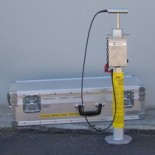 Impact Soil Tester
Impact Soil Tester 
![]()

|
|
|
|
Calibration and ServicingPlease contact us for your calibration and servicing needs.Suggested frequency of calibration and servicing: Extremely Heavy Usage/Instrument Not Well Looked After: Every Six Months Heavy Usage: Every Year Moderate Usage: Every Two Years Light Usage: Every Three Years Extremely Light Usage: Every Four Years The above frequency for calibration and servicing is suggested as a guide only. However, while we leave it up to the individual owner/operator to decide on calibration and servicing needs, from our reading of the ISO 9000 Standard (last time we looked), annual calibration is required for this type of equipment for those working to that standard. The above periods of frequency do not take into account whether calibration and servicing are required as a result of mistreatment of the instrument, circumstances or mishap that lead to damage, obvious or not, and so owners/operators need to take this into account too rather than simply abiding by the above suggested periods regardless of anything else. Also, manufacturers other than us may suggest or require calibration and servicing frequency different from the above. For example, Digital Readout Units (DRU) on Clegg Impact Soil Testers that have 882 or 883 or 884 in their model number are manufactured in the United Kingdom by our licensed manufacturer there. The manufacturer of these Digital Readout Units recommends calibration every six month. Clegg Impact Soil Testers made by us in Australia may use the English Digital Readout units and will either have 882, 883, 884 or else a “-E” (signifying an English DRU) in the model designation. Note too that we have not authorised anyone else in Australia to carry out servicing and calibration of the Clegg Impact Soil Tester (Clegg Hammer). However, if you are in North or South America, please contact Lafayette Instrument Company (www.lafayetteinstrument.com). If you are in the UK or Europe, please contact Simon Deakin Instrumentation (www.sdinst.com). If you are in New Zealand, please contact us so that we may refer you to an appropriate firm. If you are outside of these areas or have a question about calibration of the Clegg Turf Shear Tester (TST or Clegg Shear), please contact us. Outside of Australia, where we or an agent authorised by us can carry out calibration, Clegg Impact Soil Testers made in the US by Lafayette Instrument Company can only be calibrated by them or by agents they may authorise and, for Clegg Impact Soil Testers made in the UK by Simon Deakin Instrumentation, their Clegg Impact Soil Testers can only be calibrated by them or by agents they may authorise. In our experience, it is not possible for us to calibrate an unauthorised copy of the Clegg Impact Soil Tester if it has not been made in the first place to conform to either the Australian or American ASTM standards for such. If the electronics of an unauthorised copy do not conform to the established standards, we have found that they then cannot be made to operate according to the standards. Such an unauthorised copy is therefore useless in terms of testing in relation to the established standards. Note that the most common fault that occurs in the field is damage to the external signal cable which connects the drop-hammer to the readout unit (except Model DHM). It is important too with the external signal cable that the BNC connectors are fully connected, i.e. that they are 'locked' into position. Damage to the external cable may not always be obvious, e.g. a cable which checks out fine for continuity on a test bench at one gravity may have a fault due to open or short circuiting or both at the high ‘g’ forces that occur upon impact. If a cable is suspect, dispose of it and replace with a known new cable (contact us for supply). Apart from the cable, high moisture conditions and/or moisture intrusion are of concern, and repairs of damage that may result typically are costly (not such an issue with Model DHM, but still good practice to take care). Generally speaking, keep components clean and dry, especially prior to storage. A working instrument, stored away when wet, likely may not function properly or work at all next time it comes to be used (or stored away in a case or box that has got wet on the inside). Change battery/ies when a low battery symbol (may include an ‘E’ on the display upon activation) and/or a low battery phrase appears or if the display does not activate when pressing the ‘on/reset’ button (original analogue display models have a battery check position for each of the two 9 volt batteries, where, for example, movement of the needle to ‘90’ on the scale in terms of Clegg units equates to ‘9.0’ volts DC, etc.). |
|
|